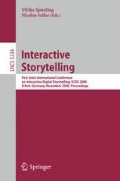Abstract
Although suspense contributes significantly to the enjoyment of a narrative by its readers, there has been little research on the automated generation of stories that evoke specific cognitive and affective responses in their readers. The goal of this research is to develop and evaluate a system that produces a narrative designed specifically to evoke suspense from the reader. The system takes as input a plan data structure representing the goals of a storyworld’s characters and the actions they perform in pursuit of them. Adapting theories developed by cognitive psychologists, the system uses a plan-based model of narrative comprehension to determine the final content of the story in order to heighten a reader’s level of suspense. This paper outlines the various components of the system and describes an empirical evaluation. The evaluation provides strong support for the claim that the system is effective in generating suspenseful stories.
Access this chapter
Tax calculation will be finalised at checkout
Purchases are for personal use only
Preview
Unable to display preview. Download preview PDF.
References
Alwitt, L.F.: Suspense and Advertising Response. Journal of Consumer Psychology 12(1), 35–49 (2002)
Brewer, W.F.: The Nature of Narrative Suspense and the Problem of Rereading. In: Vorderer, P., Wulff, H.J., Friedrichsen, M. (eds.) Suspense: Conceptualizations, Theoretical Analyses, and Empirical Explorations, pp. 107–127. Lawrence Erlbaum Associates, Mahwah (1996)
Brewer, W.F., Lichtenstein, E.H.: Stories Are to Entertain: A Structural-Affect Theory of Stories. Journal of Pragmatics 6(5-6), 437–486 (1982)
Callaway, C.B., Lester, J.C.: Narrative Prose Generation. Artificial Intelligence 139, 213–252 (2002)
Carroll, N.: Toward a Theory of Film Suspense. Persistence of Vision 1, 65–89 (1984)
Carroll, N.: The Paradox of Suspense. In: Vorderer, P., Wulff, H.J., Friedrichsen, M. (eds.) Suspense: Conceptualizations, theoretical analyses and empirical explorations, pp. 71–92. Lawrence Erlbaum Associates, Mahwah (1996)
Cavazza, M., Charles, F., Mead, S.J.: Character-Based Interactive Storytelling. IEEE Intelligent Systems 17(4), 17–24 (2002)
Cheong, Y., Young, R.M.: A Computational Model of Narrative Generation for Suspense. In: AAAI 2006 Workshop on Computational Aesthetics, pp. 8–15 (2006)
Cheong, Y., Young, R.M.: A Framework for Summarizing Game Experiences as Narratives. In: AIIDE 2006, pp. 106–108 (2006)
Comisky, P., Bryant, J.: Factors Involved in Generating Suspense. Human Communication Research 9(1), 49–58 (1982)
de Wied, M.: The Role of Temporal Expectancies in the Production of Film Suspense. Poetics 23, 107–123 (1994)
Gerrig, R., Bernardo, D.: Readers as Problem-solvers in the Experience of Suspense. Poetics 22, 459–472 (1994)
Gratch, J., Marsella, S.: Tears and Fears: Modeling Emotions and Emotional Behaviors in Synthetic Agents. In: The 5th International Conference on Autonomous Agents, pp. 278–285 (2001)
Harris, J., Young, R.M.: Proactive Mediation in Plan-Based Narrative Environments. In: Panayiotopoulos, T., Gratch, J., Aylett, R.S., Ballin, D., Olivier, P., Rist, T. (eds.) IVA 2005. LNCS, vol. 3661, pp. 292–304. Springer, Heidelberg (2005)
Kambhampati, S., Knoblock, C.A., Yang, Q.: Planning as Refinement Search: A Unified Framework for Evaluating Design Tradeoffs in Partial-Order Planning. Artificial Intelligence 76(1-2), 167–238 (1995)
Mateas, M., Stern, A.: Façade: An Experiment in Building a Fully-Realized Interactive Drama. In: Game Developer’s Conference: Game Design Track, San Jose, California (2003)
Ortony, A., Clore, G., Collins, A.: The Cognitive Structure of Emotions. Cambridge University Press, New York (1988)
Pizzi, D., Charles, F., Lugrin, J.-L., Cavazza, M.: Interactive Storytelling with Literary Feelings. In: Paiva, A.C.R., Prada, R., Picard, R.W. (eds.) ACII 2007. LNCS, vol. 4738, pp. 630–641. Springer, Heidelberg (2007)
Rattermann, M.J., Spector, L., Grafman, J., Levin, H., Harward, H.: Partial and Total-order Planning: Evidence from Normal and Prefrontally Damaged Populations. Cognitive Science 25(6), 941–975 (2002)
Riedl, M., Saretto, C.J., Young, R.M.: Managing Interaction between Users and Agents in a Multiagent Storytelling Environment. In: AAMAS 2003, pp. 741–748 (2003)
Riedl, M.O., Young, R.M.: An Intent-driven Planner for Multi-agent Story Generation. In: AAMAS 2004, pp. 186–193 (2004)
Rimmon-Kenan, S.: Narrative Fiction: Contemporary Poetics. Routledge, New York (2002)
Trabasso, T., Sperry, L.L.: Causal Relatedness and Importance of Story Events. Journal of Memory and Language 24, 595–611 (1985)
Turner, S.: The Creative Process: A Computer Model of Storytelling and Creativity. Lawrence Erlbaum Associates, Hillsdale (1994)
Vorderer, P.: Toward a Psychological Theory of Suspense. In: Vorderer, P., Wulff, H.J., Friedrichsen, M. (eds.) Suspense: Conceptualizations, Theoretical Analyses, and Empirical Explorations, pp. 233–254. Lawrence Erlbaum Associates, Mahwah (1996)
Young, R.M., Pollack, M.E., Moore, J.D.: Decomposition and causality in partial-order planning. In: AIPS 1994, pp. 188–193 (1994)
Young, R.M.: Using Grice’s Maxim of Quantity to Select the Content of Plan Descriptions. Artificial Intelligence 115, 215–256 (1999)
Zillmann, D.: The Psychology of Suspense in Dramatic Exposition. In: Vorderer, P., Wulff, H.J., Friedrichsen, M. (eds.) Suspense: Conceptualizations, theoretical analyses and empirical explorations, pp. 199–232. Lawrence Erlbaum Associates, Mahwah (1996)
Author information
Authors and Affiliations
Editor information
Editors and Affiliations
Rights and permissions
Copyright information
© 2008 Springer-Verlag Berlin Heidelberg
About this paper
Cite this paper
Cheong, YG., Young, R.M. (2008). Narrative Generation for Suspense: Modeling and Evaluation. In: Spierling, U., Szilas, N. (eds) Interactive Storytelling. ICIDS 2008. Lecture Notes in Computer Science, vol 5334. Springer, Berlin, Heidelberg. https://doi.org/10.1007/978-3-540-89454-4_21
Download citation
DOI: https://doi.org/10.1007/978-3-540-89454-4_21
Published:
Publisher Name: Springer, Berlin, Heidelberg
Print ISBN: 978-3-540-89424-7
Online ISBN: 978-3-540-89454-4
eBook Packages: Computer ScienceComputer Science (R0)

